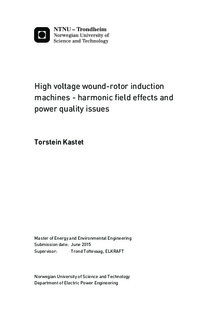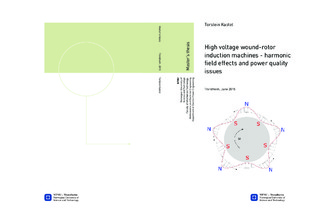| dc.description.abstract | The last few decades, harmonic content in the power system has increased dramatically, due to more complex power systems containing more power electronics and other nonlinear loads. The background for this work is a severe voltage quality problem causing lighting flicker at low voltage end consumers in a rural area in Norway. It is assumed that interharmonic components occurring close to the fifth and the seventh harmonic frequencies, creating a beat interaction with the associated integer harmonic components, resulted in the low frequent voltage disturbance. These interharmonic components occur during operation of three large high-voltage wound rotor induction motors installed at a hydro pumping station. The main objective of this work is to investigate the source of the interharmonic components.
A mathematical description of a rotor-stator interaction is presented. Here, an integer harmonic component in machine rotor is reflected through the air gap over to machine stator. In machine stator reference frame, this component occur as an interharmonic component at a different frequency, due to machine slip. For this to happen, an integer harmonic component is required as the source for the interharmonic.
To investigate this, laboratory tests on an induction machine in the laboratory at NTNU is conducted. A six-pulse, diode rectifier is used as a harmonic source, feeding the motor with harmonics. In addition, a large upstream inductance is connected. This inductance reduces network strength and allow the machine and the rectifier to distort the voltage. Simulations and calculations are carried through to verify functionality of laboratory setup.
In the laboratory tests no interharmonic component occur when an external harmonic source feed the motor with harmonics. However, when the external harmonic source is disconnected, the induction motor generates interharmonic components by itself. It is noted that a weak grid is necessary for the interharmonic components to occur in machine voltage and that a stiff network do suppress the interharmonic components generated by the motor.
Test results indicate that the induction motors at the hydro pumping station are the harmonic sources themselves. It is considered very likely that induction machines at the pumping station generate harmonics in rotor. Then, a rotor-stator interaction reflects rotor harmonics to machine stator, occurring at an interharmonic frequency, due to machine slip. Calculations of the interharmonic frequencies are very close to verify a rotor-stator interaction. Deviations of around 1 % separate measured and calculated frequencies. It is concluded that these deviations could be caused by a combination of inaccuracy in measurement equipment, machine rotor speed and by data quality reduction during post processing of data.
Further, laboratory tests show that a beat phenomenon between two harmonic components could occur in any wound rotor induction machine. A weak power grid or a harmonic resonance could result in power quality issues. | |

